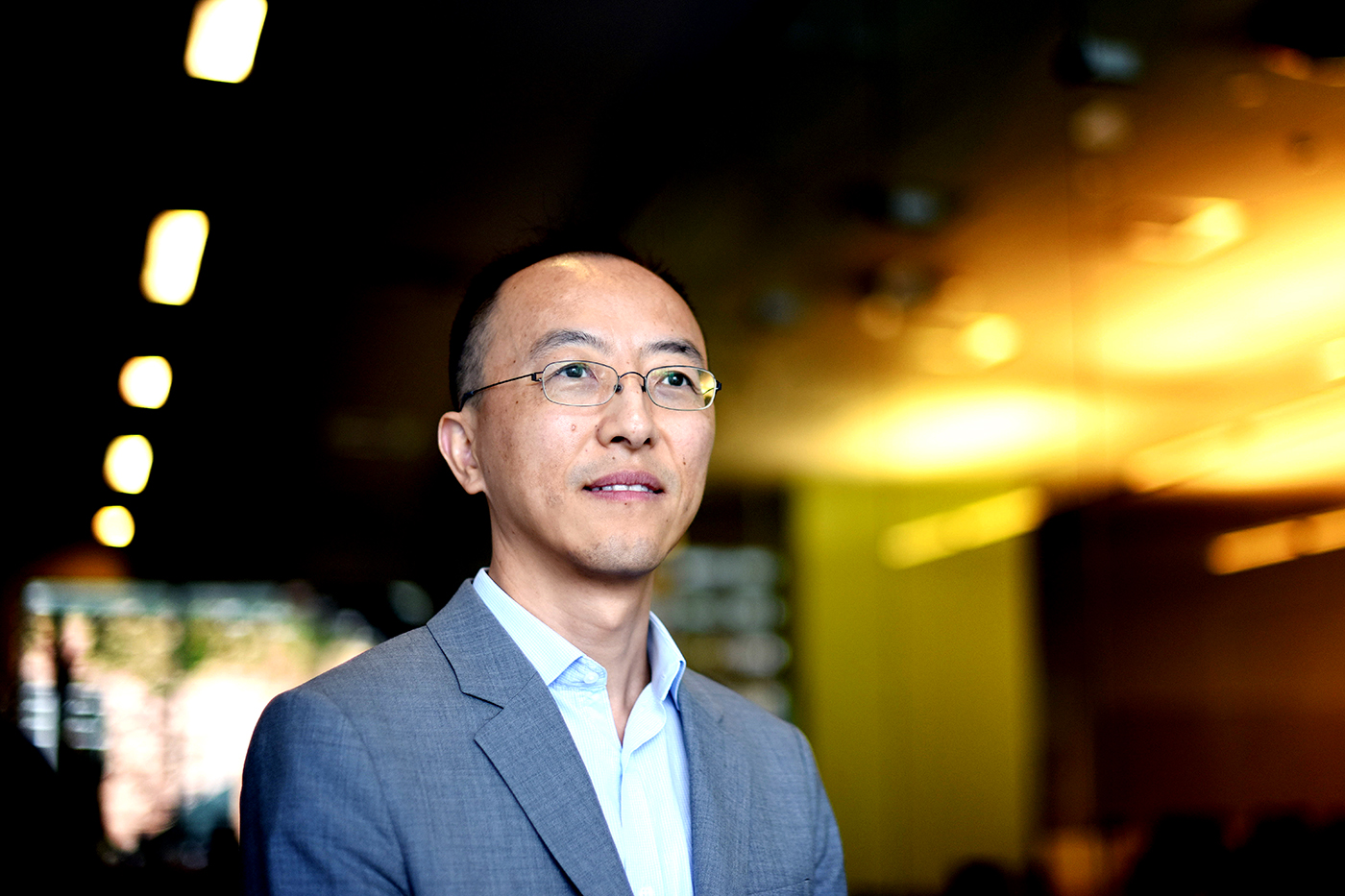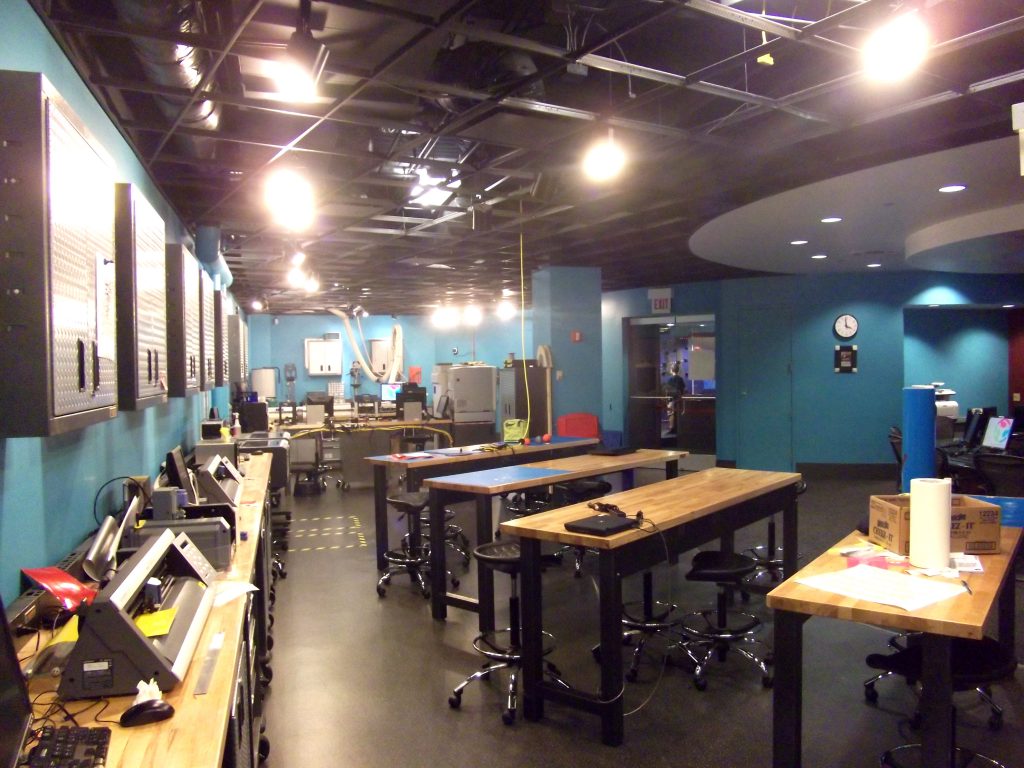In the eroded badlands of Argentina’s northern Patagonia, sedimented layers of Upper Cretaceous deposits at Auca Mahuevo offer a one of a kind view of the largest nesting site of fossilized sauropod dinosaur eggs. The intact hatching ground of the long-necked, large herbivores that roamed this exceptionally preserved land 80 million years ago was discovered in 1997 and, since then, has revealed many secrets about the reproductive habits of sauropods and their anatomical development. This dinosaur egg “sanctuary” in the lateral swamps of large streams and rivers where dinosaurs ceremoniously deposited their eggs would, later on, be gently covered by water, causing the muddy sheet-floods to bury the eggs and nests. The preserved fossils contain some of the most interesting remains ever found, from tiny embryonic bones to patches of delicate fossilized skin, and even a skull and teeth of one of the creatures.
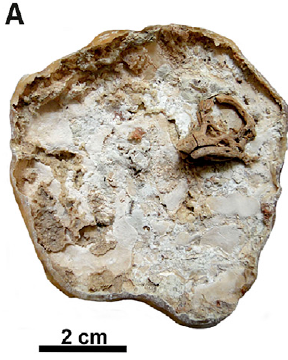
Sediment filling the egg with the embryonic skull in situ. (Image courtesy of Martin Kundrat and the journal Current Biology)
Twenty-three years after the groundbreaking discovery, researchers report the first 3D images of the preserved embryo of a sauropod. A new scientific study published in the journal Current Biology on August 27, 2020, described the first near-intact embryonic sauropod skull analyzed from first-hand observations of 3D virtual high-resolution models. The new findings, led by Martin Kundrat of the Paleo BioImaging Lab at Pavol Jozef Šafárik University, in the Slovak Republic, add to the understanding of the development of sauropod dinosaurs, a group characterized by long necks and tails and small heads, and suggests that they may have had specialized facial features as hatchlings that changed as they grew into adults.
“The specimen studied in our paper represents the first 3D preserved embryonic skull of a sauropod sauropodomorph,” said Kundrat, who is also an Associate Professor in Evolutionary and Developmental Biology at the Pavol Jozef Šafárik University. “The most striking feature is head appearance, which implies that hatchlings of giant dinosaurs may differ in where and how they lived in their earliest stages of life. But because it differs in facial anatomy and size from the sauropod embryos of Auca Mahuevo, we cannot rule out that it may represent a new titanosaurian dinosaur.”

Martin Kundrat at the European Synchrotron Radiation Facility (ESRF) in Grenoble. (Image courtesy of Martin Kundrat)
The scientists recognized a well-exposed skull inside a fragmented egg, preserved in three dimensions with most bones virtually intact and articulated. Although the skull is visibly exposed on its left side, the 3D morphology and internal structure of all the preserved bones became accessible to the researchers through virtual replicas produced using scanning and imaging tools at the European Synchrotron Radiation Facility (ESRF) in Grenoble.
In the study, Kundrat’s team used imaging technology called synchrotron microtomography to study the inner structure of bones, teeth, and soft tissues of the embryonic dinosaur. The scans allowed Kundrat and co-author Daniel Snitting, from Sweden’s Uppsala University, to find hidden details, including tiny teeth preserved deeply in tiny jaw sockets. They also discovered many previously unknown anatomical details in the cranial bones, including embryonic braincase components that kept their original shape and what appear to be the remains of temporal muscles.

The outer fragment of the original egg. (Image courtesy of Martin Kundrat and the journal Current Biology)
According to the researchers, sauropodomorph embryology remains one of the least explored areas of the life history of dinosaurs. But these new 3D models allowed investigators to reconstruct the most plausible appearance of the skull in titanosaurian sauropods before hatching, with useful details for taxonomic or developmental comparisons among related dinosaurs.
The preserved embryonic skull inside the fragmented fossil egg was scanned using the ESRF’s beamline ID 19, a multi-purpose long (145 m) imaging beamline. The scans were collected with propagation phase-contrast synchrotron microtomography using a pink beam with two different energies. Once the scanned data of the specimen was complete, the researchers turned to Mimics, a medical 3D image-based engineering software from Materialise, one of the leading providers of additive manufacturing software in Belgium, for the segmentation and 3D rendering of the skull.
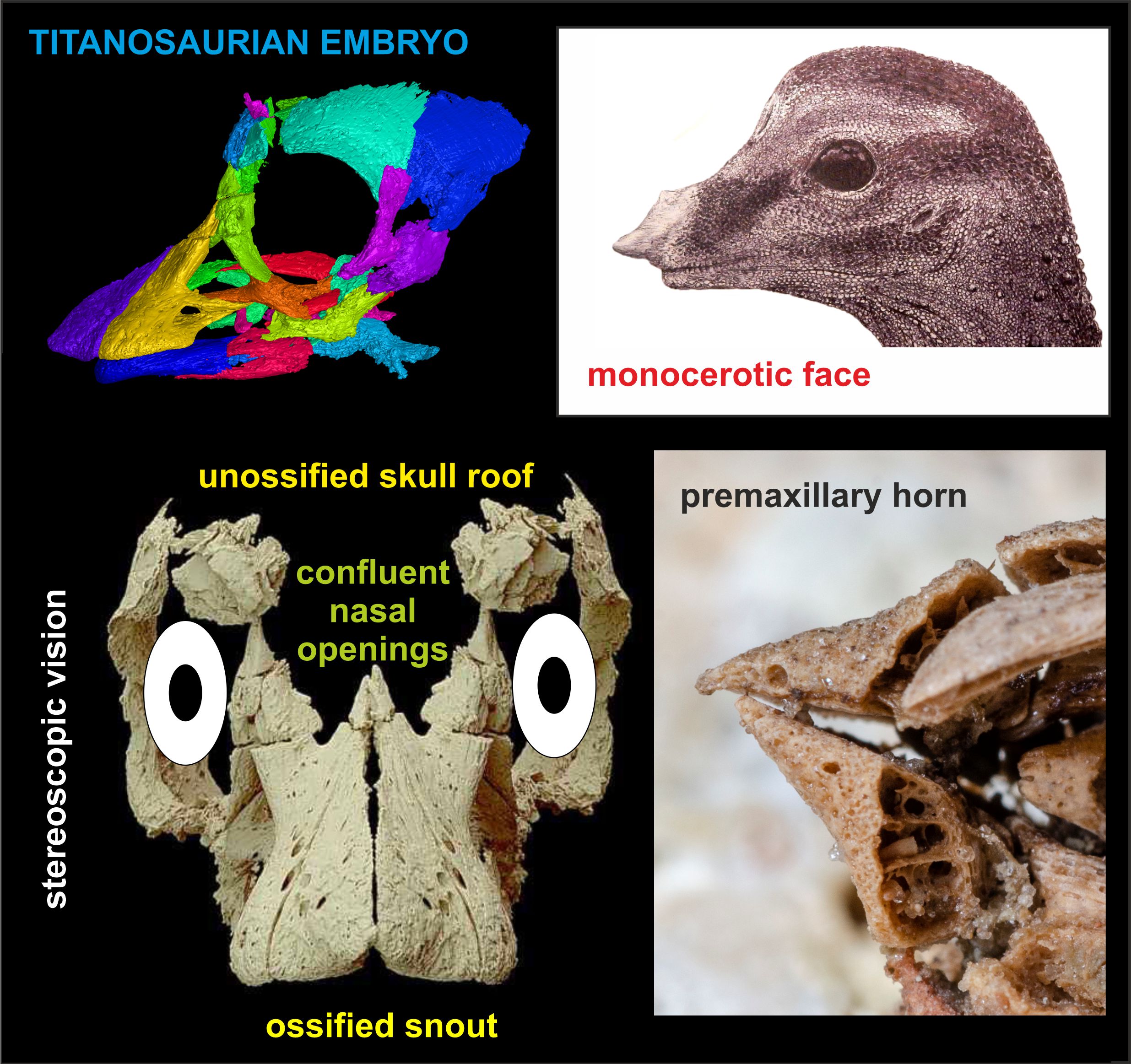
On the left: digital reconstruction of the cranial bones and reconstruction of the skull in anterior view showing incomplete skull roof. On the right: reconstruction of the head appearance by Vladimir Rimbala and premaxillary horn of embryonic skull. (Image courtesy of Martin Kundrat and the journal Current Biology)
Finally, the scientists reconstructed the internal structure and vasculature of the premaxilla (a pair of small cranial bones at the very tip of the upper jaw) thanks to German software provider Volume Graphics’ VGStudio Max 2.2, one of the most advanced software platforms for industrial CT data analysis and visualization.
Once the researchers had the 3D models, they were able to analyze the details in the sauropod’s prenatal cranial ossification. Kundrat and the study’s co-authors suggest “an alternative head appearance for babies of these Patagonian giants,” with a specialized head and face that transformed as the young dinosaurs grew and matured into adults. In fact, the visually enlightening findings suggest that the baby sauropods may have hatched out of the egg with the help of a thickened epidermal prominence rather than using a boney “egg-tooth.” The team also uncovered evidence that the titanosaurian hatchlings emerged with a temporary single-horned face, retracted openings on the nose, and early binocular vision.

Left: the craniofacial region in ventral view showing the premaxillary and maxillary alveoli and the rostral premaxillary projection forming a basis of the horn-like process. Middle: the skull in antero-ventral view. Right: 3D rendered first mesial premaxillary teeth. (Image courtesy of Martin Kundrat and the journal Current Biology)
“Our study revealed several new aspects about the embryonic life of the largest herbivorous dinosaurs that lived on our planet. A horned faced and binocular vision are features quite different from what we expected in titanosaurian dinosaurs,” added Kundrat. “Dinosaur eggs are for me like time capsules that bring a message from the ancient time. This was the case of our specimen that tells a story about Patagonian giants before they hatched.”
The work is expected to enlighten the understanding of dinosaurs and how they lived. This newly unveiled reconstruction enabled experts to recreate anatomical aspects based on intact cranial features never seen before, revealing biological and geochemical characters that distinguish the new specimen from previously described titanosaurian embryos from Auca Mahuevo.
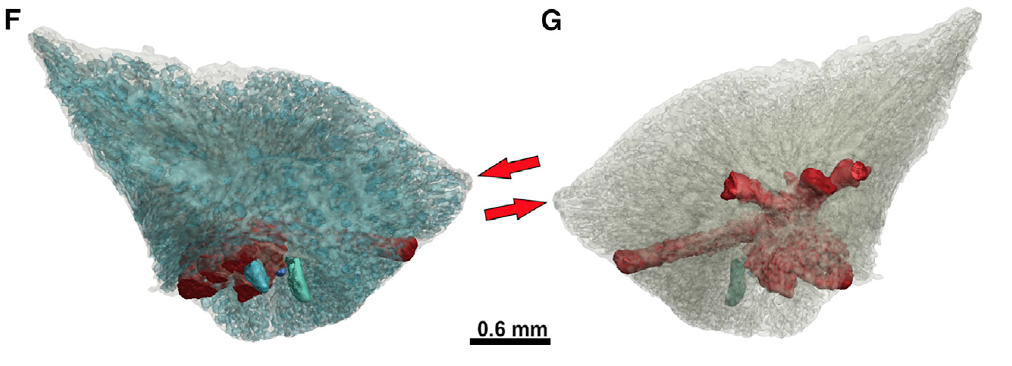
3D rendering of the opaque and semi-transparent premaxilla in medial and lateral views. (Image courtesy of Martin Kundrat and the journal Current Biology)
Although the egg fragment was originally illegally exported from Argentina and brought to researchers’ attention only later when study co-author Terry Manning, a Paleo Technician in Arizona, realized the unique preservation and scientific importance of the specimen, it is now housed in the Museo Municipal “Carmen Funes” in Plaza Huincul, just miles from the Auca Mahuevo fossil site in Argentina under the curation of paleontologist Rodolfo Coria, who is also a co-author of the study.
For decades, the extraordinary discovery of the Late Cretaceous sauropod dinosaur nesting ground has fascinated researchers worldwide. The dozens of intact eggs opened a window to understanding the life of the giant sauropods, and particularly their reproductive habits and early life. Now, 3D imaging and scanning technology can help uncover new traits and anatomy of these dinosaurs, with details never before seen.
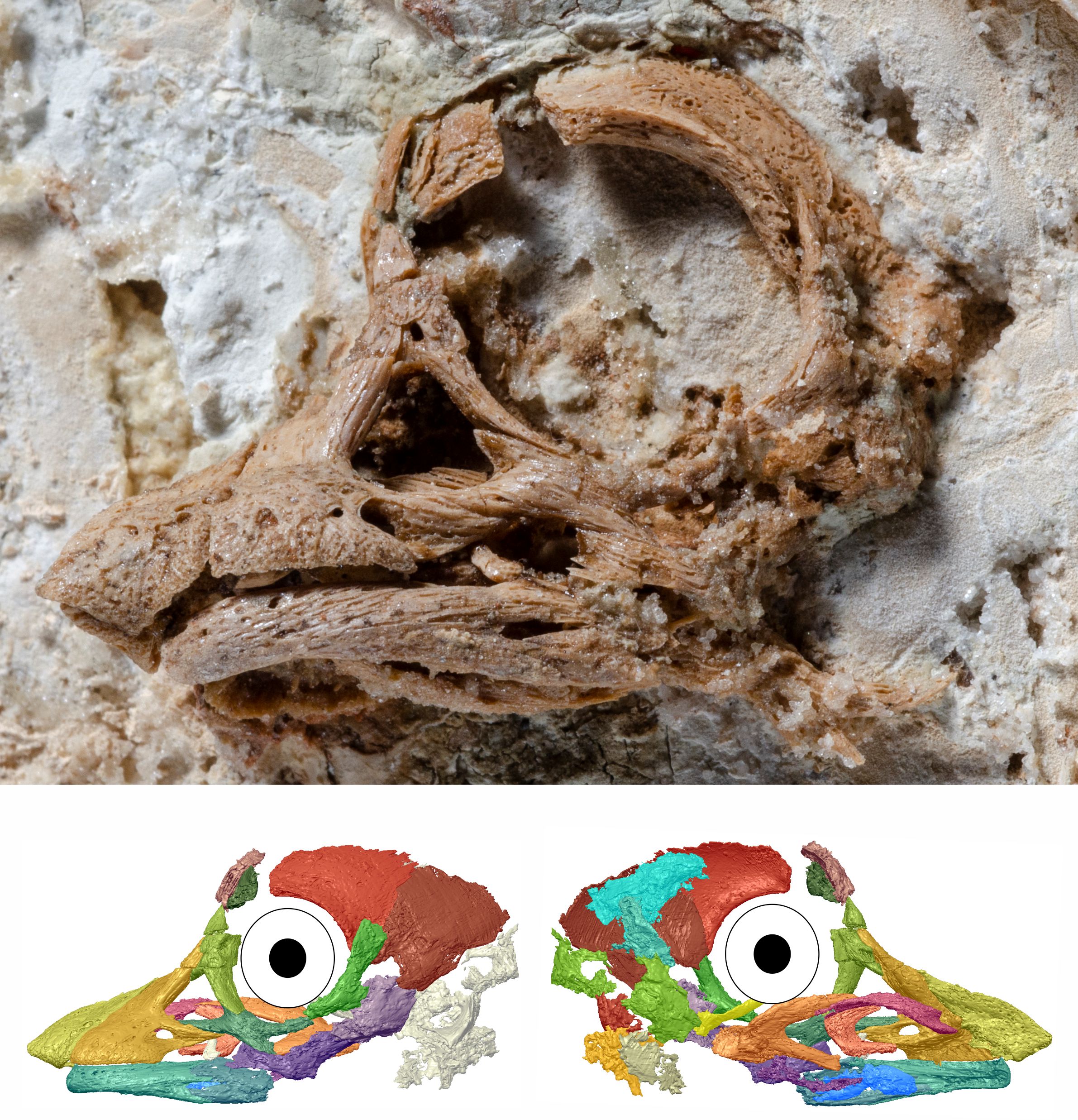
A magnified perspective of the embryonic Titanosaurian skull along with a skull reconstruction. (Image courtesy of Martin Kundrat and the journal Current Biology)
The post Dinosaurs: First 3D Model of Embryonic Sauropod Reveals New Facial Features appeared first on 3DPrint.com | The Voice of 3D Printing / Additive Manufacturing.


